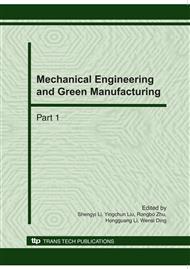[1]
Tsai Jer-Shyong, Liao Chung-Li. Finite-element modeling of static surface errors in the peripheral milling of thin-walled workpieces. Journal of Materials Processing Technology, 1999, Vol. 94: 235-246.
DOI: 10.1016/s0924-0136(99)00109-0
Google Scholar
[2]
Sebastien Seguy, Gilles Dessein, Lionel Arnaud. Surface roughness variation of thin wall milling, related to modal interactions. International Journal of Machine Tools and Manufacture, 2008, Vol. 48: 261-274.
DOI: 10.1016/j.ijmachtools.2007.09.005
Google Scholar
[3]
Wan Min, Zhang Weihong, Qiu Kepeng. Numerical Prediction of Static Form Errors in Peripheral Milling of Thin-Walled Workpieces With Irregular Meshes. Journal of Manufacturing Science and Engineering, 2005, Vol. 127: 13-22.
DOI: 10.1115/1.1828055
Google Scholar
[4]
Wan M., Zhang W.H., Qin G.H. Strategies for error prediction and error control in peripheral milling of thin-walled workpiece. International Journal of Machine Tools and Manufacture, 2004, Vol. 48(12-13): 1366-1374.
DOI: 10.1016/j.ijmachtools.2008.05.005
Google Scholar
[5]
Bai Wanjin, KeYinglin, Wu Hongbing, etc. Numerical Simulation and Analysis of Symmetry and Step-symmetry Milling of Aerospace Thin-walled Workpiece. China Mechanical Engineering, 2009, 20(2): 214-217.
Google Scholar
[6]
Yang Liuqing, DeVor Richard E., Kapoor Shiv G. Analysis of Force Shape Characteristics and Detection of Depth-of-Cut Variations in End Milling. Journal of Manufacturing Science and Engineering, 2005, Vol. 127: 454-462.
DOI: 10.1115/1.1947207
Google Scholar
[7]
Yuan Ping, Ke Ying-Lin, Dong Hui-Yue. Trochoid-path-based FEM simulation for high-speed milling of aluminum alloy. Journal of Zhejiang University(Engineering Science), Vol. 43(3): 570-577.
Google Scholar
[8]
Yang Yong, Ke Ying-lin, Dong Hui-yue. Constitutive model of aviation aluminum-alloy material in metal machining. The Chinese Journal of Nonferrous Metals, 2005, Vol. 15(6): 854-859.
Google Scholar


